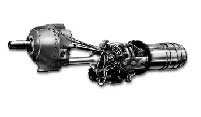Sun, Dec 16, 2012
Rolls-Royce Engine Powers Legacy C-130 Aircraft
The United States Air Force has completed flight testing for the latest enhancement for the Rolls-Royce T56 engine, and preliminary results have exceeded expectations for reduced fuel consumption and reliability improvements. The Rolls-Royce T56 engine powers all legacy C-130 aircraft, with the Series 3.5 program the latest improvement aimed at enhancing performance. Recent flight tests with an installed Series 3.5 engine demonstrated a 9.7 per cent reduction in fuel consumption and more than 22 per cent increase in reliability, achieved through a significant reduction in operating temperatures.

“The flight test data from the USAF demonstrates even better results than were expected," said Tom Hartmann, Rolls-Royce, Senior Vice President – Defence. The USAF flight test team has confirmed that by inserting new technology we can bring dramatic improvements in fuel consumption and engine reliability to C-130 operators.”
The C-130H test aircraft completed its flights in October at Edwards Air Force Base, CA. A final report on the test data is expected later in the year, with Accelerated Mission Testing under way at Rolls-Royce facilities in Indianapolis. Certification of the Series 3.5 by the FAA and qualification by the USAF are expected in 2013. The Series 3.5 engine enhancement uses proven technologies from other Rolls-Royce commercial and military engines, including new materials for blades and vanes, and advanced aerodynamic designs for turbine airfoils. The Series 3.5 will also improve performance in ‘hot and high’ conditions, and dramatically reduce emissions.
The Series 3.5 engine enhancement will enable the USAF to continue to operate its C-130H fleet until 2040, and a USAF analysis estimated its long-term savings from the program could exceed $2 billion. The engine improvements can be accomplished as part of a conventional engine overhaul, and do not require any aircraft or engine control system modifications. Each C-130 aircraft has four Rolls-Royce T56 engines, with approximately 220 USAF C-130H models eligible for updating.
The Series 3.5 program will help the Air Force to achieve its goal of reducing consumption of aviation fuel by 10 percent by 2015.
(T56 engine pictured in file image)
More News
Also: B-29 Superfortress Reunion, FAA Wants Controllers, Spirit Airlines Pulls Back, Gogo Galileo Van's Aircraft posted a short video recapping the goings-on around their reorganiz>[...]
Light Gun A handheld directional light signaling device which emits a brilliant narrow beam of white, green, or red light as selected by the tower controller. The color and type of>[...]
"The journey to this achievement started nearly a decade ago when a freshly commissioned Gentry, driven by a fascination with new technologies and a desire to contribute significan>[...]
"Our driven and innovative team of military and civilian Airmen delivers combat power daily, ensuring our nation is ready today and tomorrow." Source: General Duke Richardson, AFMC>[...]
Aircraft Conflict Predicted conflict, within EDST of two aircraft, or between aircraft and airspace. A Red alert is used for conflicts when the predicted minimum separation is 5 na>[...]
 Airborne 04.16.24: RV Update, Affordable Flying Expo, Diamond Lil
Airborne 04.16.24: RV Update, Affordable Flying Expo, Diamond Lil ANN's Daily Aero-Term (04.20.24): Light Gun
ANN's Daily Aero-Term (04.20.24): Light Gun Aero-News: Quote of the Day (04.20.24)
Aero-News: Quote of the Day (04.20.24) Aero-News: Quote of the Day (04.21.24)
Aero-News: Quote of the Day (04.21.24) ANN's Daily Aero-Term (04.21.24): Aircraft Conflict
ANN's Daily Aero-Term (04.21.24): Aircraft Conflict



